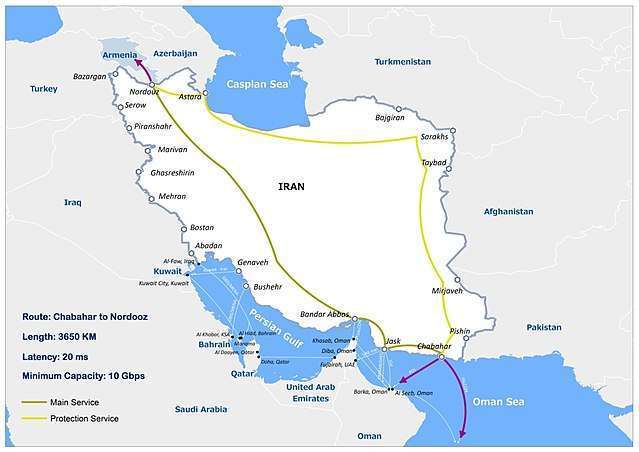Chinese interests in Iranian ports

Geopolitical Report ISSN 2785-2598 Volume 15 Issue 9
Author: Silvia Boltuc
The opening of the first Chinese consulate in Iran, in the port city of Bandar Abbas, will boost Beijing’s investments on the Iranian coast of the Gulf of Oman. Beijing aims to establish several Chinese companies in the Makran region and connect Iranian ports to its Belt and Road Initiative.
The Iranian port of Chabahar, located in the Gulf of Oman, is a trilateral project based on the collaboration between Iran, India, and Afghanistan. This infrastructure would have allowed Afghanistan access to the sea for its trade and connected it to the corridors involving Indian goods in transit through Eurasia, making the country itself an essential corridor.[1] To India, which has invested considerable resources in this infrastructure and manages it, the port provides an alternative route to Pakistan for its exports to Kabul, the Central Asian Republics, and Russia and Europe’s markets. When launching the Chabahar port project, Pakistan forbids Indian’s goods transit through its territory.[2] Thanks to Chabahar, Iran has built its first deep-sea port located outside the Strait of Hormuz and away from the problems related to its security. Furthermore, through this valuable infrastructure, the country relaunches itself as an important hub for regional and international import-export.
Being this project vital for the Indian trade, Washington exempted the port from the sanctions imposed on Iran, establishing a free economic zone.[3] The collapse of the Ghani Government in Afghanistan changed the balance by initially casting a shadow over the port after losing one of its key players. Waiting for an uncertain involvement of the new Afghan interim Government, although it has shown interest in pursuing some previous governments’ projects (an example is TAPI), things are changing for India too.[4]
By developing the port supported and strategically aligned with Washington, New Delhi’s strategy was to curb Chinese expansionism and monitor Beijing’s manoeuvres in the Arabian Sea. Contextual needs and the collapse of the previous Afghan Government offered access to China and its investments, to the point where discussions are underway to connect the Iranian port with the Chinese-led Pakistani port of Gwadar, which till now was a direct competitor.
Geopolitical consequences of Iran-China cooperation
Cooperation between China and Iran will expand thanks to the 25-year strategic pact signed by the two countries. The launch of a new Chinese consulate, the first in Iran, in the city port of Bandar Abbas will boost Beijing’s investment on the Iranian Gulf coast and offers support to the many Chinese companies planning to open in the region. Under the presidency of Rouhani, Iran had already announced its intention to develop the Makran coast.[5] Beijing will have a primary role in its development since China has reached with Pakistan a 40-year multibillion-dollar agreement to improve the Pakistani Baluchistan and the port of Gwadar. Considering that since 2016 Iran has established free trade zones of Chabahar and Bander Abbas and the industrial centres of Jask and Hormozgan.[6]
Beijing’s Belt and Road Initiative will officially include Iranian ports, while Tehran will receive 400 billion dollars in investment for infrastructure projects. China has undoubtedly considered the opportunity through Chabahar to connect to the Russian International North-South Transport Corridor (INSTC), as New Delhi is pushing for the port to be part of it. In this regard, in October, the Indian Foreign Minister Jaishankar flew to visit Armenia, a country already part of the corridor, to discuss the inclusion of the port as a bilateral strategic asset.[7]
Iran is increasingly determined to relaunch itself as a leading logistics and energy hub in the region. In this regard, Tehran has once again expressed its willingness to welcome investments by Uzbek companies in the country’s northern and southern ports. Last year, the Uzbek companies, following a framework agreement with Pakistan, the United States and Afghanistan, preferred routes through these countries. Today, due to the changed situation, Uzbekistan has proposed establishing a logistics centre in the port of Chabahar. The second meeting of the trilateral working group between India, Iran, and Uzbekistan on the joint use of the port of Chabahar was held virtually on December 14, 2021.[8] The Iranian strategy is to establish a route to transit goods from Western China using Uzbekistan’s railway network and maritime transport across the Caspian Sea. In addition, Tehran is ready to develop a transit route to Uzbekistan via neighbouring southern Arab states, including Qatar, Oman and the United Arab Emirates.
Finally, India underlined the interest of Sri Lanka and Bangladesh to be involved in the port activities. As suggested by India, they might use the Iranian port of Chabahar via Indian ports to join the North-South transit corridor (INSTC).

Conclusions
The terms of the 25-year plan between Tehran and Beijing had not been disclosed until now. China’s move to open its first consulate in Iran and the statements regarding the investment plan in the Makran region reveal part of the Chinese strategy, which aims at a massive settlement of Chinese companies in the area and to connect Iranian ports to the Belt and Road Initiative.
The Iranian port of Chabahar turned from being part of a strategy aimed at undermining Chinese expansionism leading Washington to exempt the area from sanctions into a strategic asset of the Belt and Road Initiative. Furthermore, in the short term, the port of Chabahar could be linked to the Chinese-led Pakistani port of Gwadar.
Although India had invested in the port as part of its anti-Chinese and anti-Pakistani strategies, it still gained essential benefits in terms of connections and trade. As a matter of fact, through Chabahar, New Delhi connects to INSTC and can access Central Asian, Russian and European markets.
Iran officially becomes a focal point of the most critical regional corridors and a significant energy and logistics hub. Now more than ever, it is vital that the country finalize a new nuclear deal to resume its oil & gas exports, thanks to the renewed port facilities and storage depots strategically built near them.
Sources
[1] Silvia Boltuc (2021) Geopolitica del porto iraniano di Chabahar, Geopolitical Report Vol.6, ASRIE Analytica. Retrieved from: https://www.specialeurasia.com/2021/07/14/geopolitica-del-porto-iraniano-di-chabahar/.
[2] Prabha Raghavan (2021) Explained: Why is Pakistan lifting its ban on Indian imports?, The Indian Express. Retrieved from: https://indianexpress.com/article/explained/explained-why-pakistan-wants-to-lift-its-ban-on-cotton-sugar-imports-from-india-7252808/#:~:text=Pakistan%20on%20Wednesday%20decided%20to,cotton%20and%20sugar%20from%20India.
[3] Abdul Kerimkhanov (2018) U.S. releases Iranian port Chabahar from sanctions, AzerNews. Retrieved from: https://www.azernews.az/region/140527.html.
[4] Giuliano Bifolchi, Silvia Boltuc (2021) The new geopolitical game in Afghanistan, Geopolitical Report Vol.11(1), SpecialEurasia. Retrieved from: https://www.specialeurasia.com/2021/09/01/afghanistan-geopolitics/; Silvia Boltuc (2021) Russia discussed with India security cooperation in Afghanistan, SpecialEurasia. Retrieved from: https://www.specialeurasia.com/2021/09/10/russia-discussed-with-india-security-cooperation-in-afghanistan/; Taliban and Turkmenistan discussed the TAPI pipeline project (2021), SpecialEurasia. Retrieved from: https://www.specialeurasia.com/2022/01/17/taliban-turkmenistan-tapi/.
[5] Pir-Mohammad Mollazehi (2016) From Gwadar to Chabahar, the Makran Coast Is Becoming an Arena for Rivalry Between Powers, The Wire. Retrieved from: https://thewire.in/south-asia/from-gwadar-to-chabahar-the-makran-coast-is-becoming-an-arena-for-rivalry-between-powers.
[6] Expert opinion on the bill regarding establishment of Jask trade and industrial free zone in Hormozgan Province and Special Economic Zone for pharmaceutical industry in Alborz Province (2020),Islamic Parliament Research Center Of The Islamic Republic Of Iran. Retrieved from: https://rc.majlis.ir/en/news/show/923945.
[7] India, Armenia discuss using Chabahar port to boost connectivity (2021) Hindustan Times. Retrieved from: https://www.hindustantimes.com/india-news/india-armenia-discuss-using-chabahar-port-to-boost-connectivity-101634122121648.html
[8] Sidhant Sibal (2021) India, Iran, Uzbekistan hold meeting to increase use of Chabahar port, WioNews. Retrieved from: https://www.wionews.com/india-news/india-iran-uzbekistan-hold-meeting-to-increase-use-of-chabahar-port-436959.
Analaysis in media partnership with Notizie Geopolitiche. It is possible to read the Italian version of the analysis at the following link: Silvia Boltuc (2022) I porti iraniani si aprono alla Cina, Notizie Geopolitiche. For more information about the Islamic Republic of Iran, it is possible to visit our section Iran or contact our team at info@specialeurasia.com.
